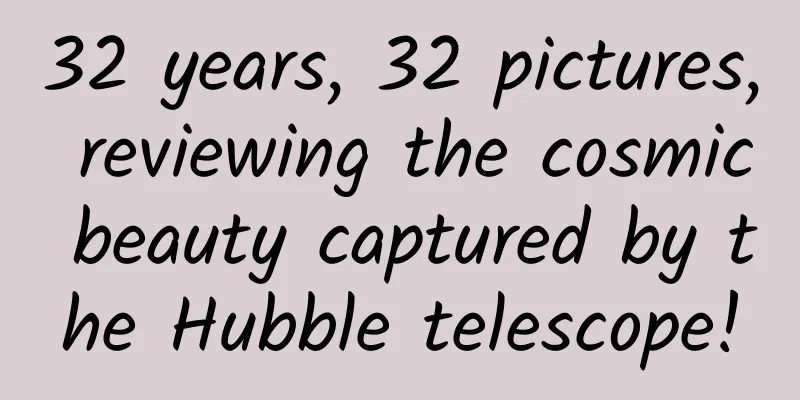32 years, 32 pictures, reviewing the cosmic beauty captured by the Hubble telescope!

|
The famous Hubble Space Telescope is 32 years old this year. It has been taking pictures of the universe for many years. Let's review it together. Image source: NASA official website The Hubble Space Telescope (HST) is a joint project of NASA and the European Space Agency (ESA). The space shuttle Discovery was launched on April 24, 1990, and then the Hubble Telescope was put into orbit on April 25. ▲Hubble Space Telescope (Image source: NASA) This telescope in space, completely free from the interference of the Earth's atmosphere, allows us to glimpse the true face of the universe. Hubble has been very busy for decades, watching galaxies, comets, asteroids, nebulae, planets and stars, and has imaged about 50,000 celestial targets more than 1.5 million times. Over the past 32 years, Hubble has undergone multiple space repairs and survived a series of technical failures. Even though the latest generation James Webb Telescope is already in orbit, the aging observatory still exists and continues to operate. Next, let us learn about the great achievements of this telescope along with these wonderful images of the universe. 1991: First color photo of Jupiter In 1991, the Hubble telescope, which had just been put into operation, brought us a surprise. Using its Wide Field Planetary Camera, the Hubble telescope took the first color photo of Jupiter. Materials such as ammonia ice in Jupiter's atmosphere form banded clouds, and in the lower right corner is Jupiter's famous Great Red Spot - a giant storm cyclone that has existed for centuries and is larger than the Earth in diameter. This was just a small test for the fledgling Hubble, and after maintenance and upgrades, it took more high-definition photos of Jupiter. 1992: The center of the elliptical galaxy NGC 4261 This slightly blurry image shows the disk-like structure at the center of the elliptical galaxy NGC 4261. This disk, about 300 light-years in diameter, is composed of cold gas and dust, which is also the source of matter for the black hole at the center of the galaxy. Its nearly 60° inclination allows astronomers to clearly discern its internal structure. Supermassive black holes frantically accrete surrounding matter, producing strong explosions and forming radio jets. 1993: Swan Circle This image of a small portion of the Cygnus Loop (also known as radio source W78), a massive supernova remnant in the constellation Cygnus, shows in unprecedented detail the edge of the shockwave from a massive stellar explosion about 15,000 years ago. 1994: The center of the spiral galaxy Messier 100 When the Hubble Space Telescope was launched, the photos it took were slightly blurry due to a tiny defect in the mirror. In December 1993, NASA carried out the first maintenance on the Hubble Telescope. NASA astronauts corrected the mirror defect, upgraded the wide-angle planetary camera to the second generation, and also updated the computer, solar panels, gyroscopes and other equipment. This photo of the spiral structure of the brightest galaxy in the Virgo Cluster was taken by the Hubble Telescope shortly after the upgrade. 1995: Pillars of Creation Many readers must be familiar with this photo. This is one of the most famous works of the Hubble Telescope. It is composed of 32 photos and shows the pillars of gas and dust in the open nebula called Eagle Nebula (M16). The tallest "pillar" is 4 light-years long. The Pillars of Creation are formed by the process of photoevaporation: ultraviolet light from newborn stars causes the gas in the nebula to escape, and the gas and dust that have not yet "evaporated" form this beautiful image. 1996: Gravitational lensing of the galaxy cluster 0024+1654 Although the bright area in the center of the picture is eye-catching, let's focus on the blue ring object in the picture first. Count them, are there 5 blue objects? In fact, they are all the same galaxy! The cause of this phenomenon is the gravitational lens effect of the galaxy cluster 0024+1654 in the center of the picture: when the light of the blue galaxy passes by, its huge gravitational field causes the light to bend, so that we can see the rare "double image". 1997: Butterfly Nebula This planetary nebula, which resembles a butterfly spreading its wings, is also called the Minkowski 2-9 Nebula (M2-9). It was discovered by astronomer Rudolf Minkowski in 1947. Exactly 50 years later, the Hubble Telescope took a clear image of it. In the center of the Butterfly Nebula, two stars orbit each other at a very close distance, and it is even possible that a star cannibalism has occurred. 1998: Infrared image of Saturn This colorful picture of Saturn shows not the true color of Saturn, but the infrared light it reflects. The different colors reflect the distribution of Saturn's atmosphere: blue represents the atmosphere low to the clouds, whose color may be composed of ammonia ice crystals; green and yellow are the haze layers above the clouds; red and orange areas are higher up in the atmosphere; and the dark area at the south pole represents a giant hole in the clouds. 1999: Jupiter and Io Compared to the lifeless planets and satellites in the solar system, Io's more than 400 active volcanoes make it the most geologically active celestial body in the solar system, and also the object of scientists' attention. In the process of trying to find the volcanic plume of Io, the Hubble telescope accidentally captured the moment when Io passed by Jupiter in the ultraviolet and violet bands. The black circular area on the right side of the picture is the shadow of Io on Jupiter. 2000: Bright Nebula This cosmic eye may foretell the end of the sun in 6 billion years. In the constellation Aquila, 6,500 light-years from Earth, a star with a mass similar to that of the sun is approaching the end of its life. The outer gas of the star is blown into the universe, exposing its hot core. The ultraviolet radiation ionizes the outer gas, which shows the fluorescent expansion gas and the bright core in the center, forming a colorful planetary nebula - the Bright Eye Nebula (NGC 6751). 2001: The Horsehead Nebula The 2001 photo also shows a vivid image of a nebula that looks like the head of a red horse with handsome manes. The Horsehead Nebula (also known as Barnard 33) got its name from this. However, compared to the dazzling bright nebulae, the Horsehead Nebula seems a bit dim. This dark nebula is composed of cold, dense clouds of gas and dust, and its formation process is similar to that of the Pillars of Creation. (Don't remember it? Go back to the 1995 photo to review it!) 2002: Cone Nebula Another nebula. You may have countless associations with its outline, but its name is much more simple - the Cone Nebula (also known as NGC 2264). The Cone Nebula is 7 light-years long, and this picture shows the upper 2.5 light-years of the nebula. Similar to the Pillars of Creation, the Cone Nebula is also undergoing a process of "erosion". Hydrogen gas emits a dim red light under ultraviolet radiation, forming a red halo around the nebula. 2003: Omega Nebula This magnificent "big waves crashing on the shore" is part of the Omega Nebula (also known as the Swan Nebula or Messier 17), which is more than 5,000 light-years away from Earth. Although it looks dangerous, it is a cradle for the birth of a large number of stars. The "big waves" in the nebula are "artworks" carved and lit by hydrogen clouds by young massive stars: the dazzling orange-red light on the surface comes from the heated gas, while the seemingly cold green area on the left is actually the hotter gas formed after the matter leaves the nebula. 2004: AM 0644-741 In the constellation Volans, 300 million light years from Earth, the Hubble Telescope discovered a "ring" inlaid with sapphires. This unique ring-shaped structure is the result of "escape" from the collision of neighboring galaxies. The impact of the collision significantly changed the orbits of stars and gas in the galactic disk, causing them to move outward. Subsequently, the gas clouds collided and compressed, generating a large number of new stars in the ring. 2005: The Whirlpool Galaxy Spiral galaxies are named after the spiral arms that extend outward from the core, which are the home of many newborn stars. Among these galaxies, the protagonist of this photo, NGC 5194, is directly called the Whirlpool Galaxy (NGC 5194) because of its amazing standard spiral arm shape. The spiral arms serve as star-making factories, nurturing young stars by compressing hydrogen, while the central yellow core is the home of old stars. 2006: Messier 82 (Cigar Galaxy) Due to the gravitational interaction with its neighbor Messier 81, Messier 82 has experienced a rapid star birth process (i.e., starburst): in the center of the galaxy, the rate of star birth is 10 times that of the Milky Way. The radiation from the newborn stars blows away the surrounding gas, and the resulting interstellar wind compresses the gas enough to form millions of newborn stars. The red in the picture represents starburst activity photographed in the infrared band, while the blue and yellow-green represent the visible band. 2007: Carina Nebula This is the nursery of stars, but also the graveyard of stars. This dreamy image shows the central region of the Carina Nebula (NGC 3372). Outward winds and ultraviolet radiation from the giant stars create the Carina Nebula's striking appearance. 2008: Galaxy Collision The representative photo of 2008, composed of 12 pictures, shows the different stages of the rare galaxy collision scene. As the expansion of the universe accelerates, the probability of galaxy fusion is getting lower and lower, and now it is only one in a thousand. But in the early universe, the distance between galaxies was closer, so the probability of collision was also higher. 2009: Interacting galaxies Arp 194 This interacting galaxy, called Arp 194, is a complex and special system. The upper part of Arp 194 consists of a spiral galaxy, a newborn galactic nucleus, and a series of chaotic spiral arms. The lower part is a single large spiral galaxy. Connecting the two parts is a complex of several super clusters. The hot, massive stars in each cluster emit a fascinating blue light. 2010: Mystic Mountain The denser interstellar gas and dust form towering pillars. The light of nearby bright stars erodes from the outside, and the high-temperature newborn stars in the pillars also emit radiation and charged particle streams, which together carve out the jagged peaks. Between the mountains, hot ionized gas flows like a stream. Around the mountain, thin gas and dust are shrouded like clouds. This "mysterious mountain" stands quietly in the constellation of Carina 7,500 light-years away. 2011: Colliding galaxies Arp 273 The larger spiral galaxy in the photo is UGC 1810, whose disk has been deformed and twisted into the shape of a blooming flower by the gravitational influence of its companion galaxy UGC 1813. UGC 1810 is the flower, UGC 1813 is the stem, and young, hot blue stars dot the edges of the petals - just like that, the galaxy collision created a cosmic "rose". 2012: Tarantula Nebula 30 Doradus, the center of the Tarantula Nebula, is a star factory where millions of young stars compete to shine. The bright area on the left is a huge young star cluster, NGC 2070, which is only 2 million years old but has 500,000 stars. These newborn stars emit a large amount of ultraviolet light, which eats away at the hydrogen clouds surrounding the cluster. 2013: The Horsehead Nebula in infrared 12 years later, the Horsehead Nebula reappeared. Only this time, the nebula in the picture became brighter. This is because the picture was taken in the infrared band. The helium and hydrogen density in the protruding part of the nebula is higher and covered with dust, which can protect the part below from being eroded by light. It is estimated that the Horsehead Nebula will dissipate in about 5 million years. 2014: Monkey Head Nebula This Hubble image from 2014 takes us to the Monkey Head Nebula, a stellar nursery 6,400 light-years away. Ultraviolet light from newborn stars in the nebula's center (on the right) ionizes the nebula's mostly hydrogen gas, carving out bizarre shapes. 2015: Westerlund 2 Located in the constellation Carina, about 20,000 light-years from Earth, the beautiful Gum 29 nebula is like a cosmic firework. In the center of the nebula is a giant star cluster consisting of about 3,000 stars, called Westerlund 2. This star cluster is only 2 million years old, but it contains many hot, bright, and massive newborn stars, which release strong ultraviolet rays and stellar winds, carving out magnificent peaks and valleys on the surrounding gas clouds. 2016: The Bubble Nebula There are many such "bubbles" floating in the vast universe, most of which are masterpieces of stars and interstellar gas. The photo shows the Bubble Nebula (officially known as NGC 7635) with a diameter of 7 light years. At the ten o'clock position in the nebula is a hot star with a mass of about 45 times that of the sun. The stellar wind blown by the star pushes away the surrounding interstellar gas, forming a bubble-like nebula. 2017: NGC 4302 and NGC 4298 On the 27th birthday of the Hubble Telescope, astronomers used it to photograph two spiral galaxies, NGC 4302 (left) and NGC 4298 (right). They are located in the constellation Coma Berenices, 55 million light-years from Earth. Because one is facing the telescope sideways and the other is facing diagonally, they look different in the photo. If you observe the Milky Way from outside the system, it will probably look similar. 2018: Lagoon Nebula At the center of the photo, a newborn star 200,000 times brighter than our sun breaks out of its cocoon, releasing ultraviolet light and a fierce stellar wind that tears through the thick interstellar gas and dust around it. All this is happening in the Lagoon Nebula, a giant stellar nursery. The Hubble Telescope has taken us across 4,000 light-years to witness this extraordinary scene of star birth. 2019: Southern Crab Nebula This is the Southern Crab Nebula (officially known as Hen 2-104), thousands of light years away from Earth. At the center of the nebula is a binary star system consisting of a red giant and a white dwarf. The outer material of the red giant is constantly ejected outward, attracted by the gravity of the white dwarf, and fills the gap between the two stars, forming this unique hourglass-like shape. 2020: Red Nebula and Blue Nebula The Red Nebula (NGC 2014) and the Blue Nebula (NGC 2020) are star-forming regions in the Large Magellanic Cloud 163,000 light-years away. The Red Nebula is like a coral reef floating in the vast sea of stars, so this photo is also called the Cosmic Reef. The Red Nebula contains a large number of bright and huge stars, with masses as high as 10-20 times that of the Sun; the Blue Nebula was formed by a series of eruptions from a star 200,000 times brighter than the Sun. 2021: Superstar on the brink of destruction Astronomers have pointed the famous observatory at a brilliant celebrity star, AG Carinae, one of the brightest stars in our Milky Way galaxy, surrounded by glowing gas and dust. AG Carinae is on the brink of collapse, with the star's gravity and outward radiation engaged in a persistent tug-of-war to avoid self-destruction. The expanding shell of gas and dust surrounding the star is about five light-years wide, about the distance from us to Proxima Centauri. The giant star was formed by one or more massive eruptions about 10,000 years ago, which blew the star's outer layers into space like a boiling teapot being ejected from its lid, expelling about 10 times the mass of our Sun. Although AG Carinae is now quiescent, as an ultrahot star it continues to pour out searing radiation and a powerful stellar wind (stream of charged particles). 2022: Five galaxies in close proximity In this photo, we can see three spiral galaxies, an elliptical galaxy and a lenticular galaxy, and their layout makes us look very comfortable. This is the "Hickson Compoct Group 40" (HCG40: Hickson Compoct Group 40) located about 300 million light-years in the direction of the "Sea Snakes". From the image, the galaxies seem to be quite close to each other. In fact, the five galaxies may be less than twice the size of the Milky Way disk (about 100,000 light-years in diameter), that is, the area with a diameter of less than 200,000 light-years is dense. NASA said that they will collide in about 1 billion years and merge into a huge elliptical galaxy. Although the Hubble telescope has a very long life, it is difficult for it to witness this event. The above briefly reviews Hubble’s journey of space exploration. Thank you Hubble for your 32 years of dedication! (The content of this article is compiled from Global Science, NASA space enthusiasts, and Three-Body fans) Produced by: Science Central Kitchen Produced by: Beijing Science and Technology News | Beijing Science and Technology Media Welcome to share to your circle of friends Reproduction without authorization is prohibited |
<<: Will the epidemic affect human psychology for 20 years? Experts say so...
Recommend
How did "The BFG" that Spielberg had no interest in finally make a comeback?
Recently, the topic of Steven Spielberg in China ...
With domestic science fiction novels winning awards one after another, how long will the corresponding games remain silent?
The Hugo Award is like the Nobel Prize in the sci...
There are 100,000 marketing hot spots in May? Just chasing these 7 is enough! !
Friends in operations , advertising, and marketin...
Promotion Tips Collected Edition: Analysis of 16 Mainstream Network Promotion Channels!
There are various online promotion channels . Thi...
[Girls' Emotions] The art of falling in love with everyone: teach you how to quickly become a charming woman sought after by the opposite sex!
[Girls' Emotions] The art of falling in love ...
Reflection on the Double Eleven Carnival: Ecological Concepts Still Need to Be Consolidated
The effect of the Double Eleven Carnival, an e-co...
Super data recovery money-making project, easily earn 10,000+ per month (with tutorial data recovery software cracked version collection)
I believe everyone has the experience of accident...
How to place Momo information flow ads? Just look at this and you will know!
When the word "Momo" comes into view, a...
If you often have trouble sleeping, will Alzheimer's disease come to you?
If you often have trouble sleeping, will Alzheime...
The zebra has stripes only on half of its body. Is it because the printer is out of ink?
Densely packed animal skeletons, bizarre animal s...
Artifact recommendation! 10 niche, easy-to-use and high-end operation tools!
It is said that if the underwear is well chosen, ...
Introduction to a new implementation mechanism for keeping mobile APP logged in
[[194514]] Features of Mobile App The difference ...
The truth behind the globally controversial "room temperature superconductivity" incident turns out to be like this!
Produced by: Science Popularization China Author:...
APP planning and promotion: 3 essential qualities for screen-sweeping copywriting!
When promoting products, app planners and promote...
Are male genes disappearing? New research reveals the genetic mystery of human Y chromosomes...
The Y chromosome is the true root of a man becaus...









